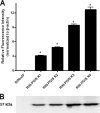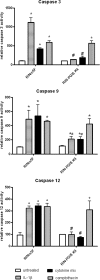Protection against cytokine toxicity through endoplasmic reticulum and mitochondrial stress prevention by prostacyclin synthase overexpression in insulin-producing cells
- PMID: 20159982
- PMCID: PMC2856989
- DOI: 10.1074/jbc.M109.054775
Protection against cytokine toxicity through endoplasmic reticulum and mitochondrial stress prevention by prostacyclin synthase overexpression in insulin-producing cells
Abstract
Proinflammatory cytokines play a crucial role in the pathogenesis of type 1 diabetes mellitus. One of the cytokine-regulated pathways mediating inflammation in this autoimmune disease is the arachidonic acid metabolism pathway, comprising both the induction of cyclooxygenases and the production of different prostaglandins. Cytokine toxicity is mediated in many cell types, including pancreatic beta cells through this pathway. Interestingly, some cell types have been shown to be insensitive to such toxicity, and this correlated with a high expression of prostacyclin synthase (PGIS). Using insulin-producing RINm5F cells as a model for pancreatic beta cells, PGIS was overexpressed and exhibited a large protective effect against cytokine toxicity. This protective effect of PGIS against cytokine toxicity correlated with a decreased activation of the transcription factor NFkappaB and the inducible NO synthase promoter as well as a reduced inducible NO synthase protein expression and nitrite production. A reduction in the cytokine-stimulated endoplasmic reticulum and mitochondrial stress was also found in the PGIS-overexpressing cells. Moreover, cytokine-induced caspase-3 activation and reduction of glucose oxidation and cell proliferation were suppressed. Thus, PGIS overexpression apparently protects insulin-producing cells against cytokine toxicity via suppression of endoplasmic reticulum and mitochondrial stress-mediated cell death pathways.
Figures




References
-
- Bach J. F. (1994) Endocr. Rev. 15, 516–542 - PubMed
-
- McDaniel M. L., Kwon G., Hill J. R., Marshall C. A., Corbett J. A. (1996) Proc. Soc. Exp. Biol. Med. 211, 24–32 - PubMed
-
- Yang Z., Chen M., Ellett J. D., Carter J. D., Brayman K. L., Nadler J. L. (2005) Am. J. Transplant 5, 475–483 - PubMed
-
- Cnop M., Welsh N., Jonas J. C., Jörns A., Lenzen S., Eizirik D. L. (2005) Diabetes 54, (Suppl. 2) S97–S107 - PubMed
-
- Eizirik D. L. (1996) Horm. Metab. Res. 28, 302–305 - PubMed
Publication types
MeSH terms
Substances
LinkOut - more resources
Full Text Sources
Medical
Molecular Biology Databases
Research Materials

